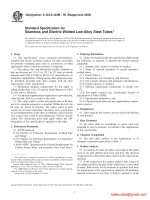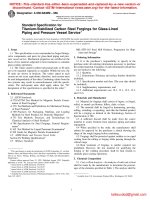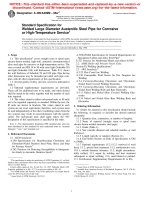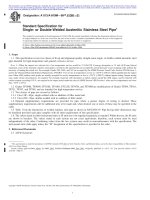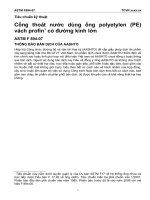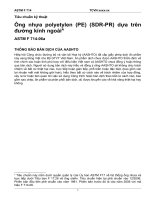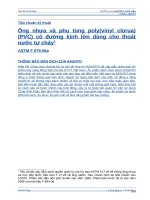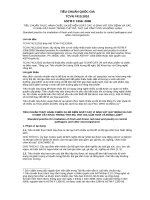Astm f 1655 95 (2013)
Bạn đang xem bản rút gọn của tài liệu. Xem và tải ngay bản đầy đủ của tài liệu tại đây (76.32 KB, 4 trang )
Designation: F1655 − 95 (Reapproved 2013)
Standard Guide for
Training First Responders Who Practice in Wilderness,
Delayed, or Prolonged Transport Settings1
This standard is issued under the fixed designation F1655; the number immediately following the designation indicates the year of
original adoption or, in the case of revision, the year of last revision. A number in parentheses indicates the year of last reapproval. A
superscript epsilon (´) indicates an editorial change since the last revision or reapproval.
1. Scope
2. Referenced Documents
2.1 ASTM Standards:2
F1177 Terminology Relating to Emergency Medical Services
F1453 Guide for Training and Evaluation of First Responders Who Provide Emergency Medical Care
F1490 Terminology Relating to Search and Rescue (Withdrawn 2011)3
1.1 This guide covers minimum training standards for first
responders who may care for sick or injured persons in the
specialized pre-hospital situations of the wilderness, delayed,
or prolonged transport settings, including catastrophic disasters.
1.2 This guide establishes supplemental or continuing education programs that will be taught to individuals trained to the
first responder level by an appropriate authority.
3. Terminology
1.3 This guide does not provide training to be used,
ordinarily, in the traditional EMS or ambulance transportation
environments.
3.1 Definitions:
3.1.1 access, n—the process of reaching the patient/subject
and establishing physical contact.
1.4 Included in this guide is a standard for the evaluation of
the knowledge and skills defined within this guide.
3.1.2 basic life support/cardiopulmonary resuscitation
(BLS/CPR) , n—a set of skills that includes airway
management, chest compressions, and others as defined by the
American Heart Association.
1.5 Successful completion of a course based on this guide
neither constitutes nor implies certification or licensure.
3.1.3 definitive care, n—a level of therapeutic intervention
capable of providing comprehensive health care services for a
specific condition. (See Terminology F1177.)
1.6 This guide does not establish medical protocols, nor
does it authorize invasive procedures without specific authorization and medical control.
3.1.4 evacuation, n—the process used between the time of
extraction and transportation. (See Terminology F1490.)
1.7 The values stated in inch-pound units are to be regarded
as standard. No other units of measurement are included in this
standard.
3.1.5 extraction, n—the process of initial assessment,
treatment, stabilization, and packaging of the patient as well as
the removal of the patient/subject from the immediately
hazardous environment. (See Terminology F1490.)
1.8 Operating within the framework of this guide may
expose personnel to hazardous materials or environments,
procedures, and equipment or all of these.
3.1.6 first responder, n—an individual trained in accordance
with Guide F1453.
1.9 This standard does not purport to address all of the
safety concerns, if any, associated with its use. It is the
responsibility of the user of this standard to establish appropriate safety and health practices and determine the applicability of regulatory limitations prior to use.
3.1.7 transportation, n—the use of a dedicated vehicle for
the removal of the patient to a medical facility or definitive care
facility.
3.2 Definitions of Terms Specific to This Standard:
1
This guide is under the jurisdiction of ASTM Committee F30 on Emergency
Medical Services and is the direct responsibility of Subcommittee F30.02 on
Personnel, Training and Education.
Current edition approved Aug. 1, 2013. Published August 2013. Originally
approved in 1995. Last previous edition approved in 2007 as F1655 – 95(2007).
DOI: 10.1520/F1655-95R13.
2
For referenced ASTM standards, visit the ASTM website, www.astm.org, or
contact ASTM Customer Service at For Annual Book of ASTM
Standards volume information, refer to the standard’s Document Summary page on
the ASTM website.
3
The last approved version of this historical standard is referenced on
www.astm.org.
Copyright © ASTM International, 100 Barr Harbor Drive, PO Box C700, West Conshohocken, PA 19428-2959. United States
1
F1655 − 95 (2013)
5.2 Rural (Delayed/Prolonged Settings)—A man was driving along a gravel road in a remote rural area of Northern
Idaho. He stooped to clear a fallen tree from the road, and in
the attempt, he fell and dislocated his right shoulder. He
managed to call for help with his CB radio. About 2 h later, an
ambulance arrived. The EMTs on the ambulance checked the
pulse and sensation in his right arm, and found them to be
normal. The man pleaded with them to pull on his shoulder and
relocate it; he had a similar dislocation of the left shoulder in
the past, and he knew that it could be reduced with a little help.
However the EMTs, mindful of their training, insisted on
“splinting it in position” and drove him six hours to the nearest
hospital, mostly along bumpy secondary roads. The patient was
moaning and intermittently screaming the entire time, in severe
pain. Later he wrote to various authorities criticizing the care
provided to him.
3.2.1 delayed or prolonged transport, n— when time between patient injury and arrival to a definitive care facility is
greater than 60 min.
3.2.2 non-traditional EMS environment, n— environments
not readily accessible to a ground ambulance.
3.2.3 wilderness first responder (WFR), n— an individual
trained to meet the requirements of this guide.
3.2.4 wilderness setting, n—situations in which EMS delivery is complicated by one or more of the following four factors:
(1) remoteness as far as logistics and access; (2) a significant
delay in the delivery of care to the patient; (3) an environment
that is stressful to both patients and rescuers; and (4) a lack of
equipment and supplies.
4. Significance and Use
4.1 Individuals will be initially or concurrently trained in
accordance with U.S. D.O.T. Course Guide for First Responders4 and Guide F1453.
5.3 Disaster (Delayed/Prolonged Settings):
5.3.1 It was rush hour, and the freeways were crowded, but
otherwise the day was like any other. Suddenly the earth shook,
and a freeway collapsed, entombing motorists in a mass of
concrete and twisted metal.
5.3.2 For four days, rescuers attacked the mass of rubble
with every tool available from pliers to massive construction
equipment. They had given up hope of finding any one else
alive when they found a 57 year old construction worker alive,
his lower extremities being trapped and crushed.
5.3.3 No medical personnel were available to render care
such as IV hydration, so the construction workers immediately
extricated him. Despite later attempts at hydration, he later
developed kidney failure and then sepsis; he died a few days
later.
4.2 This guide does not suggest a particular training sequence.
4.3 This guide may be used by individuals developing
training programs for non-traditional EMS environments.
4.4 This guide acknowledges the need to provide additional
specific training for first responders who will practice in the
wilderness, delayed or prolonged transport settings.
4.5 Individuals responsible for training first responders
should identify those who will practice in the wilderness,
delayed or prolonged transport settings and must ensure that
such personnel are competent in all skills needed for the unique
settings.
5.4 Borderline Wilderness Settings:
5.4.1 Several years ago, a light civil aircraft crashed near the
top of Tinker Mountain in southwest Virginia. Atop Tinker
Mountain’s rugged, cliff-strewn ridgeline is the Appalachian
Trail; the area is a favorite of hikers and climbers. The aircraft
was located from the air, and a team responded to the site. The
quickest way to reach the site was from a road near the bottom
of the ridge. Those responding to the site fell into two groups:
mountain rescue team members and “regular” fire/EMS personnel. Protocols for the fire/EMS personnel required them,
when responding to an air crash, to wear full turnout gear and
self-contained breathing apparatus, and to carry fire suppression equipment. The standard practice for the mountain rescue
was to carry minimal lightweight equipment, to dress appropriately for the weather and brush, to drink plenty of fluids, and
to pace themselves.
5.4.2 The Virginia summer weather was particularly hot and
humid, and the mountainside very steep. Soon many of the
fire/EMS personnel were disabled from heat exhaustion, and
one even had to be evacuated. The mountain rescue personnel
were able to handle all necessary extrication and fire suppression with what they had carried and whatever they could
improvise at the scene.
5.4.3 Survivors were treated appropriately for burns and
shock, evacuated and then transported to a local hospital.
5. Illustrative Examples
5.1 Wilderness Settings:
5.1.1 In May 1983, two climbers were at about 18 000 ft,
near Denali Pass on Mount McKinley, Alaska. These climbers
took a tumbling 800 ft fall before coming to rest. One of the
climbers was only responsive to pain, with a lacerated face and
the pick end of his ice axe impaled in the right side of his chest,
just below the nipple line. A nearby climbing party responded.
They first attempted to stabilize the ice axe in place as per
standard EMS protocols. They improvised a rescue toboggan
using two plastic sleds, but moving the patient was very
difficult with the ice axe still in his chest. And, with temperatures ranging from − 50 to − 70 °F (in accordance with National Park Service reports), rescuers were unable to keep him
from rapidly cooling. The danger of cold exposure and the
difficulty with transportation created by the impaled ice axe led
rescuers to remove it.
5.1.2 After removing the ice axe, the patient began to
rewarm, the rescuers were able to evacuate him expeditiously,
and he went on to make a full recovery.
4
U.S. D.O.T. HS 900-025, Course Guide, Emergency Medical Services, First
Responder Training Course, March 1979. Available from the Standardization
Documents Order Desk, Bldg. 4, Section D, 700 Robbins Ave., Philadelphia, PA
19111–5098. Attn: NPODS.
2
F1655 − 95 (2013)
6.1.8 Describe and demonstrate the skills needed to manage
orthopedic problems in the wilderness, delayed or prolonged
transport settings, including dislocations, fractures, and open
fractures.
6.1.9 Describe and demonstrate the skills needed to manage
spinal injuries and associated problems in the wilderness,
delayed, or prolonged transport settings.
6.1.10 Describe and demonstrate the skills needed to manage specific problems associated with cardiorespiratory arrest
in the wilderness, delayed, or prolonged transport settings.
6.1.11 Describe the uses, side effects, administration
concerns, and needed authorities for non-prescription and
prescription medications in the wilderness, delayed, or prolonged transport settings.
6.1.12 Describe measures necessary to prevent illness or
injury occurring in the wilderness, delayed, or prolonged
transport settings, including management of immediate stress
reactions.
6.1.13 Describe specific problems related to rendering care
in severe weather, in environmental extremes, when equipment
is not readily available, when access is limited, and when there
is little or no additional assistance.
6.1.14 Describe and demonstrate as feasible, clothing,
survival, emergency communications and bivouac skills necessary in environmental extremes.
6.1.15 Demonstrate patient packaging skills in the
wilderness, delayed, or prolonged transport settings.
6.1.16 Describe and demonstrate documentation requirements for recording patient care.
6.1.17 Describe any unique or specialized requirements or
obligations imposed by the EMS system or other legal principles.
6.1.18 Describe any medical control requirements and processes.
6.1.19 Describe the principles of disease transmission and
body fluid isolation and demonstrate the use of personal
protection techniques.
6. Educational Objectives
6.1 Wilderness First Responders shall be trained to perform
the following (these objectives do not suggest any specific
training order):
6.1.1 Describe the specific differences between the training
of First Responders who practice in the traditional EMS
environment and those who practice in the wilderness, prolonged or delayed transport settings where traditional patient
care is not sufficient or appropriate.
6.1.2 Recognize the differences in patient care required by
practice in the wilderness, prolonged or delayed transport
settings.
6.1.3 Describe any additional or specialized anatomy or
physiology knowledge required.
6.1.4 Identify and demonstrate the management of the
following medical problems in the wilderness, delayed or
prolonged transport settings:
6.1.4.1 Abdominal pain,
6.1.4.2 Vomiting,
6.1.4.3 Diarrhea,
6.1.4.4 Diabetes,
6.1.4.5 Seizure disorders,
6.1.4.6 Respiratory distress (for example, asthma, altitude),
6.1.4.7 Allergies,
6.1.4.8 Hypertension,
6.1.4.9 Cardiac emergencies, and
6.1.4.10 Dental emergencies.
6.1.5 Identify and demonstrate the management of illness or
injury related to or caused by the environment in the
wilderness, delayed or prolonged transport settings, including
the following:
6.1.5.1 Altitude (for example, acute mountain sickness, high
altitude pulmonary edema, high altitude cerebral edema, solar
radiation),
6.1.5.2 Barotrauma,
6.1.5.3 Cold (for example, hypothermia, frostbite),
6.1.5.4 Heat (for example, heat stroke, heat exhaustion,
burns),
6.1.5.5 Electrical and lightning,
6.1.5.6 Exposure to plant or animal (for example, insect,
reptile, arachnid, marine) toxins,
6.1.5.7 Drowning, near-drowning, and cold water
immersion, and
6.1.5.8 Dehydration.
6.1.6 Describe the proper disinfection of water and identify
and manage illnesses associated with improper water disinfection.
6.1.7 Describe and demonstrate the skills needed to manage
open wounds in the wilderness, delayed, or prolonged transport
settings.
7. Evaluation
7.1 Policies for evaluation, grading, pass/fail criteria, remediation and re-education shall be established and distributed to
all students.
7.2 End of course cognitive and psychomotor evaluations
that measure the competency of the WFR in the objectives of
this guide shall be given.
8. Keywords
8.1 delayed; first responder; pre-hospital; prolonged; wilderness
3
F1655 − 95 (2013)
ASTM International takes no position respecting the validity of any patent rights asserted in connection with any item mentioned
in this standard. Users of this standard are expressly advised that determination of the validity of any such patent rights, and the risk
of infringement of such rights, are entirely their own responsibility.
This standard is subject to revision at any time by the responsible technical committee and must be reviewed every five years and
if not revised, either reapproved or withdrawn. Your comments are invited either for revision of this standard or for additional standards
and should be addressed to ASTM International Headquarters. Your comments will receive careful consideration at a meeting of the
responsible technical committee, which you may attend. If you feel that your comments have not received a fair hearing you should
make your views known to the ASTM Committee on Standards, at the address shown below.
This standard is copyrighted by ASTM International, 100 Barr Harbor Drive, PO Box C700, West Conshohocken, PA 19428-2959,
United States. Individual reprints (single or multiple copies) of this standard may be obtained by contacting ASTM at the above
address or at 610-832-9585 (phone), 610-832-9555 (fax), or (e-mail); or through the ASTM website
(www.astm.org). Permission rights to photocopy the standard may also be secured from the ASTM website (www.astm.org/
COPYRIGHT/).
4

